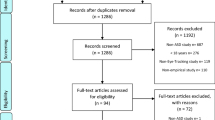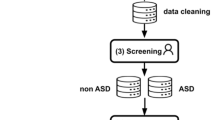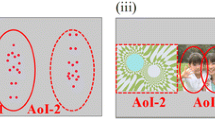Abstract
Eye tracking (ET) holds potential for the early detection of autism spectrum disorder (ASD). To overcome the difficulties of working with young children, developing a short and informative paradigm is crucial for ET. We investigated the fixation times of 37 ASD and 37 typically developing (TD) children ages 4–6 watching a 10-second video of a female speaking. ASD children showed significant reductions in fixation time at six areas of interest. Furthermore, discriminant analysis revealed fixation times at the mouth and body could significantly discriminate ASD from TD with a classification accuracy of 85.1%, sensitivity of 86.5%, and specificity of 83.8%. Our study suggests that a short video clip may provide enough information to distinguish ASD from TD children.


Similar content being viewed by others
References
Akshoomoff, N., Corsello, C., & Schmidt, H. (2006). The role of the Autism Diagnostic Observation Schedule in the assessment of autism spectrum disorders in school and community settings. The California School Psychologist, 11, 7–19.
Annaz, D., Campbell, R., Coleman, M., Milne, E., & Swettenham, J. (2012). Young children with autism spectrum disorder do not preferentially attend to biological motion. Journal of Autism and Developmental Disorders, 42(3), 401–408. https://doi.org/10.1007/s10803-011-1256-3.
Bolte, S., Bartl-Pokorny, K. D., Jonsson, U., Berggren, S., Zhang, D., Kostrzewa, E., … Marschik, P. B. (2016). How can clinicians detect and treat autism early? Methodological trends of technology use in research. Acta Paediatrica, 105(2), 137–144. https://doi.org/10.1111/apa.13243.
Chawarska, K., & Shic, F. (2009). Looking but not seeing: Atypical visual scanning and recognition of faces in 2 and 4-year-old children with autism spectrum disorder. Journal of Autism and Developmental Disorders, 39(12), 1663–1672. https://doi.org/10.1007/s10803-009-0803-7.
Council on Children With Disabilities, Section on Developmental Behavioral Pediatrics, Bright Futures Steering Committee, & Medical Home Initiatives for Children With Special Needs Project Advisory Committee (2006). Identifying infants and young children with developmental disorders in the medical home: An algorithm for developmental surveillance and screening. Pediatrics, 118(1), 405–420. https://doi.org/10.1542/peds.2006-1231.
Crippa, A., Marzocchi, G. M., Piroddi, C., Besana, D., Giribone, S., Vio, C., … Sora, M. L. (2015). An integrated model of executive functioning is helpful for understanding ADHD and associated disorders. Journal of Attention Disorders, 19(6), 455–467. https://doi.org/10.1177/1087054714542000.
Dalton, K. M., Nacewicz, B. M., Johnstone, T., Schaefer, H. S., Gernsbacher, M. A., Goldsmith, H. H., … Davidson, R. J. (2005). Gaze fixation and the neural circuitry of face processing in autism. Nature Neuroscience, 8(4), 519–526. https://doi.org/10.1038/nn1421.
Delahunty, C. (2015). Developmental delays and autism: Screening and surveillance. Cleveland Clinic Journal of Medicine, 82(11 Suppl 1), 29–32. https://doi.org/10.3949/ccjm.82.s1.06.
Deshpande, G., Libero, L. E., Sreenivasan, K. R., Deshpande, H. D., & Kana, R. K. (2013). Identification of neural connectivity signatures of autism using machine learning. Frontiers in Human Neuroscience, 7, 670. https://doi.org/10.3389/fnhum.2013.00670.
Elsabbagh, M., & Johnson, M. H. (2016). Autism and the social brain: The first-year puzzle. Biological Psychiatry, 80(2), 94–99. https://doi.org/10.1016/j.biopsych.2016.02.019.
Falck-Ytter, T., Bolte, S., & Gredeback, G. (2013). Eye tracking in early autism research. Journal of Neurodevelopmental Disorders, 5(1), 28. https://doi.org/10.1186/1866-1955-5-28.
Falck-Ytter, T., Fernell, E., Hedvall, A. L., von Hofsten, C., & Gillberg, C. (2012). Gaze performance in children with autism spectrum disorder when observing communicative actions. Journal of Autism and Developmental Disorders, 42(10), 2236–2245. https://doi.org/10.1007/s10803-012-1471-6.
Falkmer, T., Anderson, K., Falkmer, M., & Horlin, C. (2013). Diagnostic procedures in autism spectrum disorders: A systematic literature review. European Child & Adolescent Psychiatry, 22(6), 329–340. https://doi.org/10.1007/s00787-013-0375-0.
Frazier, T. W., Strauss, M., Klingemier, E. W., Zetzer, E. E., Hardan, A. Y., Eng, C., & Youngstrom, E. A. (2017). A meta-analysis of gaze differences to social and nonsocial information between individuals with and without autism. Journal of the American Academy of Child & Adolescent Psychiatry, 56(7), 546–555. https://doi.org/10.1016/j.jaac.2017.05.005.
Fujioka, T., Inohara, K., Okamoto, Y., Masuya, Y., Ishitobi, M., Saito, D. N., … Kosaka, H. (2016). Gazefinder as a clinical supplementary tool for discriminating between autism spectrum disorder and typical development in male adolescents and adults. Molecular Autism, 7, 19. https://doi.org/10.1186/s13229-016-0083-y.
Fujisawa, T. X., Tanaka, S., Saito, D. N., Kosaka, H., & Tomoda, A. (2014). Visual attention for social information and salivary oxytocin levels in preschool children with autism spectrum disorders: An eye-tracking study. Frontiers in Neuroscience, 8, 295. https://doi.org/10.3389/fnins.2014.00295.
Hampton, J., & Strand, P. S. (2015). A review of level 2 parent-report instruments used to screen children aged 1.5-5 for autism: A meta-analytic update. Journal of Autism and Developmental Disorders, 45(8), 2519–2530. https://doi.org/10.1007/s10803-015-2419-4.
Jones, W., Carr, K., & Klin, A. (2008). Absence of preferential looking to the eyes of approaching adults predicts level of social disability in 2-year-old toddlers with autism spectrum disorder. Archives of General Psychiatry, 65(8), 946–954. https://doi.org/10.1001/archpsyc.65.8.946.
Klin, A., Lin, D. J., Gorrindo, P., Ramsay, G., & Jones, W. (2009). Two-year-olds with autism orient to non-social contingencies rather than biological motion. Nature, 459(7244), 257–261. https://doi.org/10.1038/nature07868.
Kong, X., Wang, B., Park, J., & Kong, J. (2017). Introduction of a new video-based eye tracking paradigm for early detection of ASD. The North American Journal of Medicine and Science, 10(4), 133–135. https://doi.org/10.7156/najms.2017.1004133.
Kosmicki, J. A., Sochat, V., Duda, M., & Wall, D. P. (2015). Searching for a minimal set of behaviors for autism detection through feature selection-based machine learning. Translational Psychiatry, 5, e514. https://doi.org/10.1038/tp.2015.7.
Lai, M. C., Lombardo, M. V., & Baron-Cohen, S. (2014). Autism. Lancet, 383(9920), 896–910. https://doi.org/10.1016/S0140-6736(13)61539-1.
Liu, W., Li, M., & Yi, L. (2016). Identifying children with autism spectrum disorder based on their face processing abnormality: A machine learning framework. Autism Research, 9(8), 888–898. https://doi.org/10.1002/aur.1615.
Moody, E. J., Reyes, N., Ledbetter, C., Wiggins, L., DiGuiseppi, C., Alexander, A., … Rosenberg, S. A. (2017). Screening for autism with the SRS and SCQ: Variations across demographic, developmental and behavioral factors in preschool children. Journal of Autism and Developmental Disorders, 47(11), 3550–3561. https://doi.org/10.1007/s10803-017-3255-5.
Scarpa, A., Reyes, N. M., Patriquin, M. A., Lorenzi, J., Hassenfeldt, T. A., Desai, V. J., & Kerkering, K. W. (2013). The modified checklist for autism in toddlers: Reliability in a diverse rural American sample. Journal of Autism and Developmental Disorders, 43(10), 2269–2279. https://doi.org/10.1007/s10803-013-1779-x.
Sharma, S. R., Gonda, X., & Tarazi, F. I. (2018). Autism spectrum disorder: Classification, diagnosis and therapy. Pharmacology & therapeutics. https://doi.org/10.1016/j.pharmthera.2018.05.007.
Shic, F., Macari, S., & Chawarska, K. (2014). Speech disturbs face scanning in 6-month-old infants who develop autism spectrum disorder. Biological Psychiatry, 75(3), 231–237. https://doi.org/10.1016/j.biopsych.2013.07.009.
Speer, L. L., Cook, A. E., McMahon, W. M., & Clark, E. (2007). Face processing in children with autism: Effects of stimulus contents and type. Autism, 11(3), 265–277. https://doi.org/10.1177/1362361307076925.
Sterling, L., Dawson, G., Webb, S., Murias, M., Munson, J., Panagiotides, H., & Aylward, E. (2008). The role of face familiarity in eye tracking of faces by individuals with autism spectrum disorders. Journal of Autism and Developmental Disorders, 38(9), 1666–1675. https://doi.org/10.1007/s10803-008-0550-1.
Wiggins, L. D., Bakeman, R., Adamson, L. B., & Robins, D. L. (2007). The utility of the Social Communication Questionnaire in screening for autism in children referred for early intervention. Focus on Autism and Other Developmental Disabilities, 22(1), 33–38.
Zhang, X., Li, J., Qin, M., & Zhang, C. (1994). The revise of Gesell Developmental Scale on 3.5–6 years of age in Beijing. Chinese Journal of Clinical Psychology, 2(3), 148–150.
Zwaigenbaum, L., & Penner, M. (2018). Autism spectrum disorder: Advances in diagnosis and evaluation. BMJ, 361, k1674. https://doi.org/10.1136/bmj.k1674.
Funding
This study was funded by Sanming Project of Medicine in Shenzhen (SZSM201512009). JK is supported by R01 AT008563, R21AT008707, and R61AT009310 from NIH/NCCIH.
Author information
Authors and Affiliations
Contributions
GW, XK, YL, JK contributes experimental design; GW, BS, YL, ZW, ZF contributes data collection; SY, YT, BS, MK contributes data analysis; JK, SY, GW, XK, YT, JP, CL contributes manuscript preparation.
Corresponding authors
Ethics declarations
Conflict of interest
JK has a disclosure to report (holding equity in a startup company (MNT) and pending patents to develop new neuromodulation tools) but declares no conflict of interest. All other authors declare no conflict of interest.
Ethical Approval
All procedures performed in studies involving human participants were in accordance with the ethical standards of the Shenzhen Maternity & Child Healthcare Hospital research committee and with the 1964 Helsinki declaration and its later amendments or comparable ethical standards.
Informed Consent
Informed consent was obtained from parents of all individual participants included in the study. We are grateful to Georgia J Wilson for her help in revising the manuscript.
Rights and permissions
About this article
Cite this article
Wan, G., Kong, X., Sun, B. et al. Applying Eye Tracking to Identify Autism Spectrum Disorder in Children. J Autism Dev Disord 49, 209–215 (2019). https://doi.org/10.1007/s10803-018-3690-y
Published:
Issue Date:
DOI: https://doi.org/10.1007/s10803-018-3690-y




